
Testing setup
Test procedure.
For these test I used the JetBoil stove in a remote canister configuration, this was done as the stove is lower so I could use a variety of windshields.

JB stove used as remote canister stove
The stove was placed on my test bench with a small pedestal fan placed a meter away, I placed my old Vane Anemometer on the bench and tested wind speed which was measured at around 12kph (note, the wind speed feels faster that 12 kph but I could be wrong) I then attached the stove to the canister and took note of weight, measured 500g of water in pot, replaced lid.
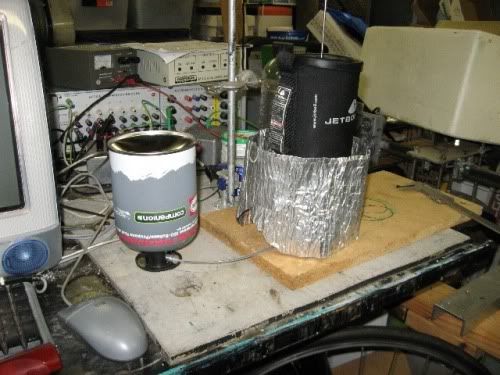
Test with MSR windshield
I then placed stove on test bench, placed thermistor in pot at 1 cm from bottom, started data logging program and at 10 second started stove and adjusted to a high flame setting, when water temperature reached 95º stopped stove, removed pot and re-weighed canister, noting the new weight. From logged data start temp was noted and fuel used was normalized to grams of fuel used per 80º (g/80C)
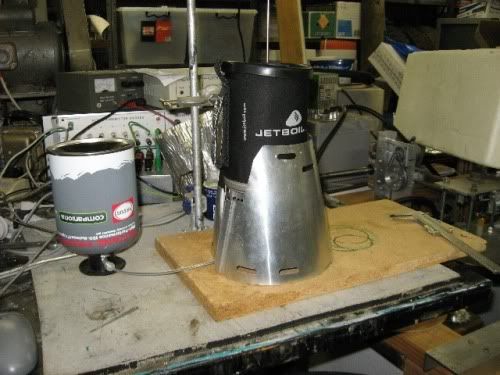
Using Caldera cone windshield
The tests
The first test was with no windshield and no wind, (no W no WS) this is used a base line figure. Results, fuel per 80ºC = 6.1 g
The second test was with the fan on but no windshields (W no WS). Results, fuel per 80ºC = 8.2 g
The third test was with fan on and using an old MSR wind screen (W MSR WS) which was placed completely around and secured together with a clip. Results, fuel per 80ºC = 7.4 g
The fourth test was using a Trail designs Caldera Cone windscreen (W CC WS) , this windscreen is designed for a BPL Ti 550 pot and was too small to fit over the JB pot with the cozy on it, so I placed the windscreen as best as I could around the pot with the gap opposite the fan, the fuel line came out this gap. Results, fuel per 80ºC = 6.9 g
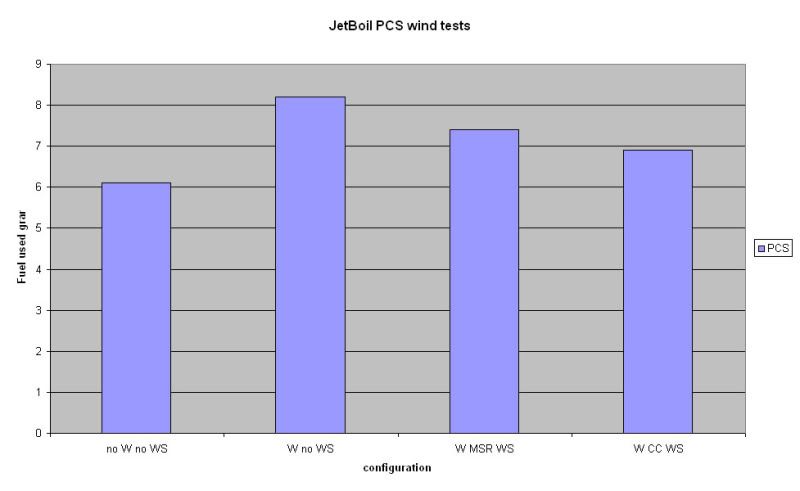 Comparison of PCS wind tests
Comparison of PCS wind testsBelow is the heating rate graph, the fastest boil (pink line) is the test with no wind the slowest is the test with wind but no windshield.
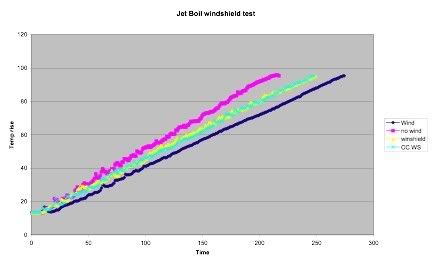
Wind tests heating rates
Discussion of results.
First I wish to point out that these tests are not what I would call scientific, I only did one run per test and with canister gas stoves they are very hard to adjust to repeat runs, but there is a trend that fits in with what I was expecting.
The result clearly show that there is a reduction of efficiency with the introduction of wind, and that a windshield does make a difference, the tests also show that the JetBoil PCS stove is not too badly effected by moderate winds, I was actually surprised how little loss of efficiency the JB system has with no windshield., from past tests with a normal upright stove with no windscreen there was a much high loss, I am also surprised with this system what little difference a windshield made to the efficiency and these test the CC windshield was only marginally better that the MSR windshield.
Part 2, JetBoil Group Cooking System Pot (GCS). The GCS's heat exchanger is fully exposed and I suspect it would be more vulnerable to wind.
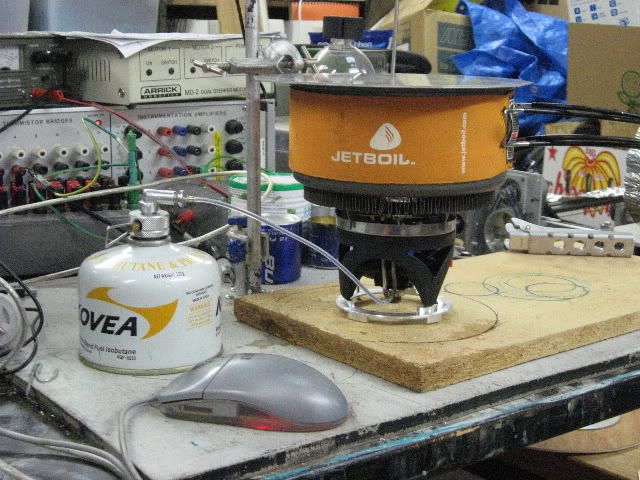
JetBoil GCS remote canister setup
Testing method
These test were done much the same as the PCS, I decided to do this to try and get better consistency in the tests, to do this I put a adjustable valve on the canister and ran the JetBoil stove until the flame at a high level and was stable I then only used the valve on the canister to turn the stove on and off. My STD 0.5 liters of water were used. The wind speed measured was around 12-15 kph.
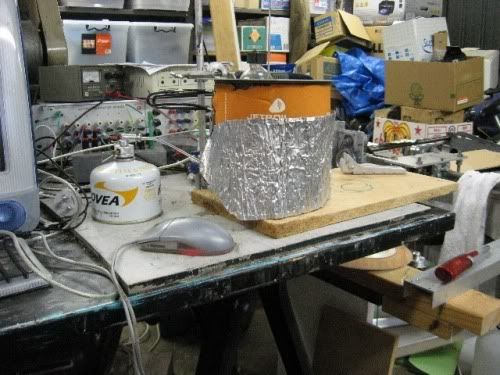
GCS stove with old MSR windscreen
Results
Test 1, GCS pot and remote canister JetBoil stove, no wind and no windscreen, Fuel used in grams per 80ºC = 5.0g
Test 2, wind with windscreen, stove was lit then windscreen placed around stove, then fan turned on. Fuel used in grams per 80ºC = 5.5g
Test 3, wind, no windscreen, During this test it was obvious that it this system is greatly effected by wind and to raise the water to 95ºC was going to take some considerable time and fuel, I stopped the tests at the same time as the no wind test and as the heating rate is usually linear I extrapolate the results.
Fuel used in grams per 80ºC = 25.4g
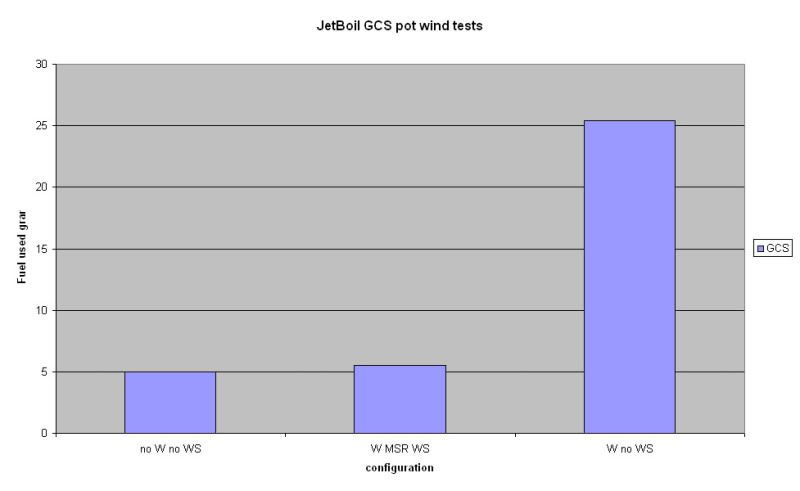
Comparison of GCS pot wind tests
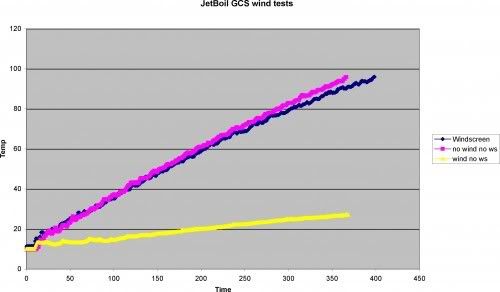
JB GCS wind tests heating rate, note the flate heating rate of the wind no windshield
Heating rate graph, pink line no wind/ no windscreen, blue line, wind/windscreen, yellow line wind/no windscreen
Discussion of results.
As can be seen from the fuel used in the wind/no windscreen test the GCS stove efficiency is affected quite a lot by wind but the use of a windscreen does improve the efficiency and possibly if the windscreen is setup properly wind may have no effect, the difference between the results of the no wind and wind/windscreen tests is very small this difference could be considered in normal testing error.
Conclusion. GCS
Unlike the PCS stove the GCS stove system efficiency is greatly affected by wind but the use of a good fitting windscreen can greatly improve efficiency to the point that the wind may have little or no effect.
Conclusion PCS vs GCS pots
As can be seen in a windless situation or when used with windscreens the PCS system is less efficient that the GCS pot system but when there is some wind around the PCS system is far superior. One thing these tests show is on most stove systems the importance of a good windshield.
I have not tested the new JetBoil Sol cooking system, I am considering getting the To version which is similar in weight to my one liter Aluminium pot, Kovea Supalite stove and windscreen.
Tony






